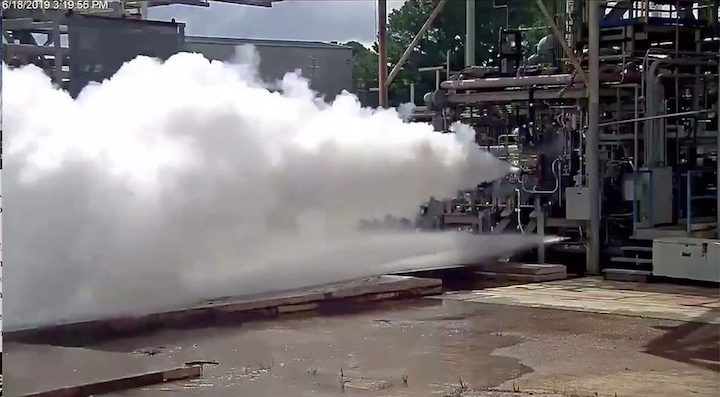4.02.2020

WASHINGTON — Blue Origin will perform tests of the engine it is developing for its Blue Moon lunar lander at a U.S. Air Force Research Lab test site, the two organizations announced Jan. 27.
AFRL and Blue Origin signed a 15-year cooperative research and development agreement, or CRADA, Dec. 11, regarding testing of Blue Origin’s BE-7 engine at AFRL’s Rocket Lab at Edwards Air Force Base in California. Financial terms of the agreement were not disclosed, but AFRL said that Blue Origin will fund “capital improvements” to a facility the company will use for engine tests.
That facility, known as site 1-42 or the Space Environment Propulsion Complex, is used for testing rocket engines and spacecraft components in upper atmospheric or vacuum conditions. Upgrades such as new liquid hydrogen and liquid oxygen propellant capabilities, AFRL said, “will allow BE-7 testing in a simulated space-like environment.”
“Repurposing the infrastructure at the 1-42 test site enables us to accelerate development of the BE-7 engine for our Blue Moon lunar lander,” Eric Blumer, senior director for the BE-7 engine program at Blue Origin, said in the statement. “It will play a critical role in Blue Origin’s support of the Artemis program to send women and men to the moon by 2024.”
The upgrades to site 1-42 will be available to other users in the future, AFRL officials said. “Facility improvements under this public private partnership will open the door for rocket engine testing beyond the BE-7 test campaigns,” said Dan Brown, chief engineer of the AFRL Rocket Lab, in the same statement. “The new test capability enables the Air Force and future commercial partners to test advanced upper stage engines at relevant altitude conditions.”
Blue Origin announced the BE-7 engine in May 2019 when it unveiled the updated design of the Blue Moon lander, which will use that engine. The BE-7, which uses liquid hydrogen and liquid oxygen propellants, is designed to produce 10,000 pounds-force of thrust and be deeply throttleable. Jeff Bezos, founder of Blue Origin, said in May that the company had been working on the BE-7 for three years.
At the May event, the company focused on using Blue Moon for cargo missions, but suggested a crewed version was also possible. In October, Blue Origin said it was offering a version of that lander, in partnership with Draper, Lockheed Martin and Northrop Grumman, for NASA’s Human Landing System program, a public-private partnership to develop landers for transporting astronauts to and from the lunar surface. NASA has yet to make any initial awards to support lander development studies under that program.
Blue Origin announced the first hotfire test of the BE-7 in June on a stand at NASA’s Marshall Space Flight Center. The company did not respond to questions about whether the company plans to continue engine testing at Marshall or shift that work to the AFRL facility. The tests at Marshall have been done on an outdoor test stand, which can’t replicate the vacuum conditions the engine will operate in on its missions.
The agreement with Blue Origin is the second such partnership involving AFRL revealed in the last month. AFRL announced Jan. 9 that it signed a CRADA last July with ABL Space Systems, a small launch vehicle startup, covering development and testing of rocket propulsion systems.
Quelle: SN
